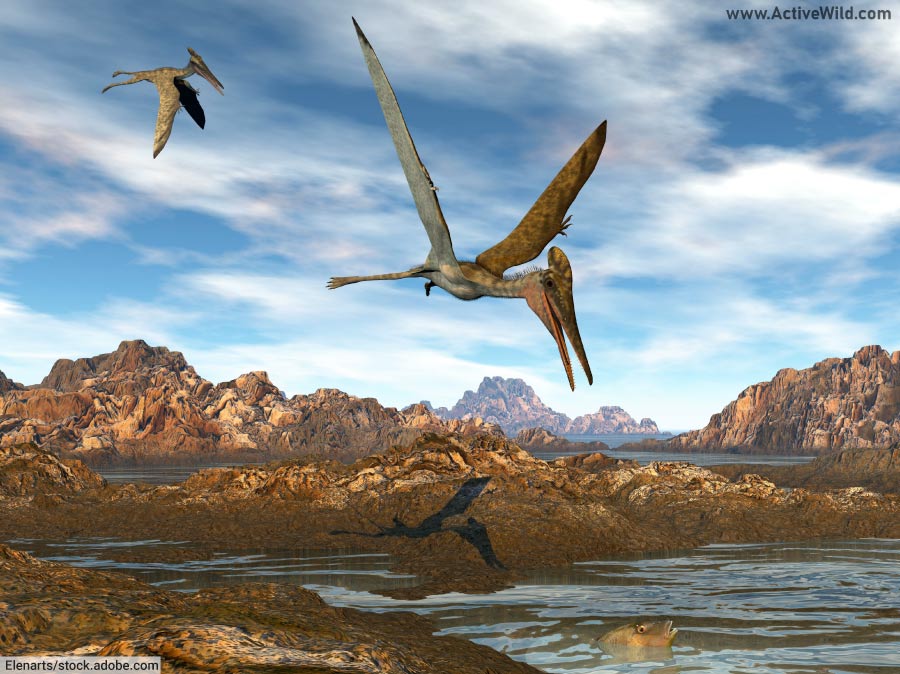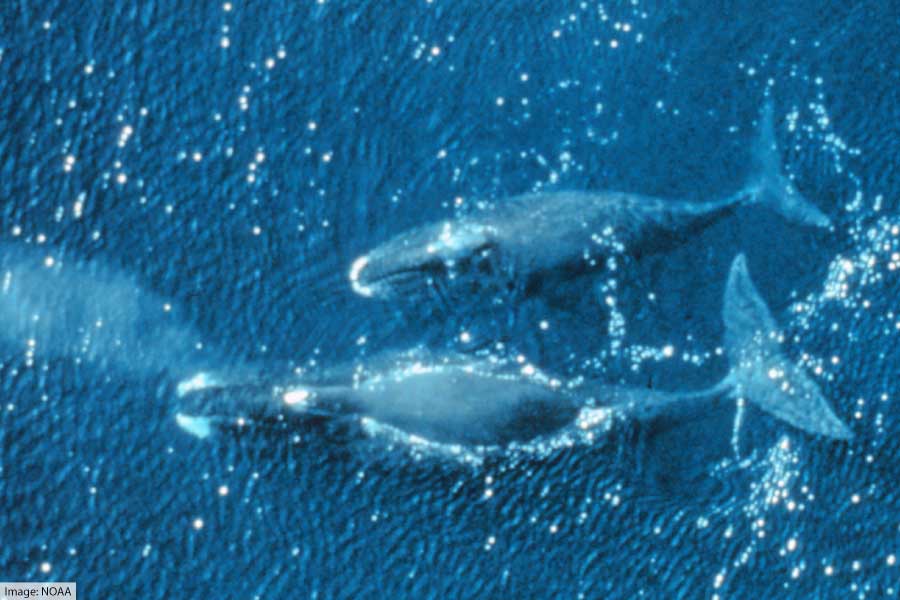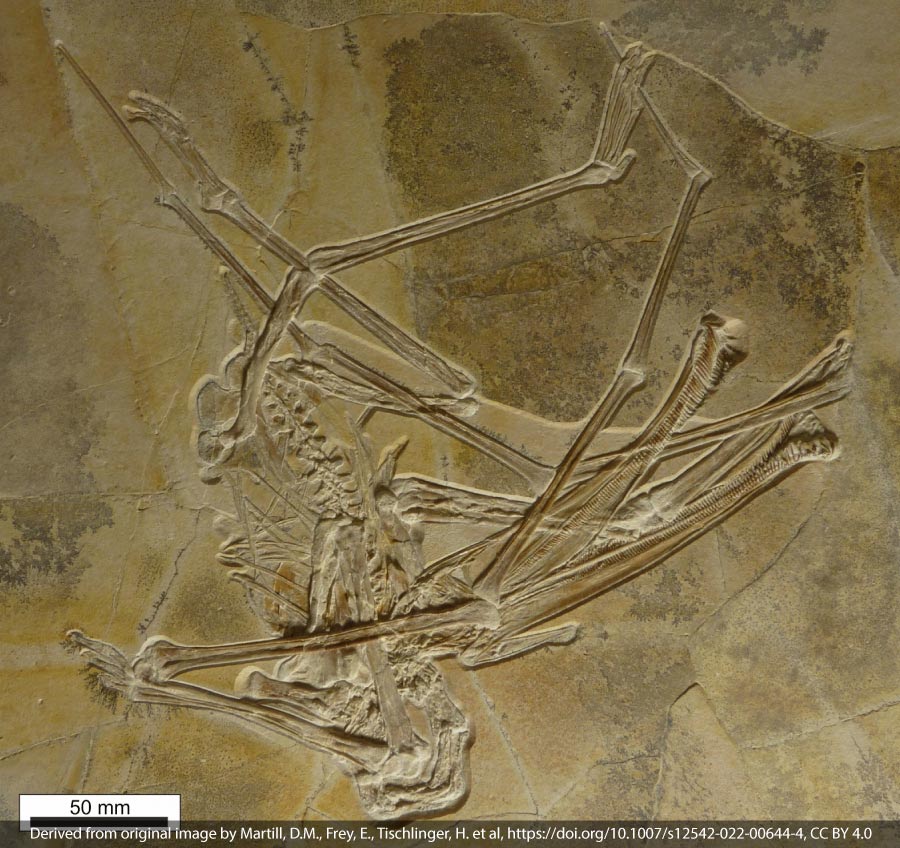The remains of a new pterosaur species have been discovered in Bavaria, Germany. The prehistoric flying reptile, which has been given the name Balaenognathus maeuseri, lived during the Jurassic Period. Its distinctive, spatula-shaped bill contained at least 480 needle-like teeth, which were likely used to filter particles of food from water.
Read on for more information on the new species…
What Did Balaenognathus maeuseri Look Like?

Balaenognathus maeuseri belonged to the suborder Pterodactyloidea, and, typically for pterosaurs in this group, had a short tail, relatively narrow wings, and extended metacarpals.
In addition, the newly-discovered pterosaur had long legs, a long neck, and an unusual, spatula-shaped bill.
Its wingspan is estimated to have been around 1.17 meters (3.8 ft); slightly larger than that of Pterodactylus antiquus, which also lived in the Late Jurassic, but far smaller than that of giants such as Quetzalcoatlus, which appeared in the Late Cretaceous Period.

Pterodactyloidea – the suborder to which Balaenognathus maeuseri belonged – was one of two main groups of pterosaurs, the other being Rhamphorhynchoidea, whose members had long tails.
- You can find out more about pterosaurs on this page: Pterosaur Facts
Pterodactyloid pterosaurs first appeared in the Middle Jurassic, and as they evolved, gradually lost their teeth. By the Late Cretaceous, no toothed pterodactyloid pterosaurs remained. (This mirrors bird evolution; the ancestors of birds (i.e. dinosaurs) had teeth, but modern birds lack teeth.)
Balaenognathus maeuseri, however, was around in the Jurassic, and had teeth in abundance; at least 480 of them, all needle-shaped and likely designed for filter feeding.

The pterosaur’s teeth lined either side of its distinctive, spatula-shaped bill, the front of which lacked teeth. This adaptation allowed water to enter the mouth before being expelled through the interlocked teeth of the upper and lower jaws. Particles of food caught by the teeth were then swallowed.
Small, hook-like extensions found at the tips of the Pterosaur's teeth may have improved the filter-feeding process.
- You can see more Jurassic animals on this page: Jurassic Animals
- You can see a list of Jurassic dinosaurs on this page: Jurassic Dinosaurs
Family
Balaenognathus maeuseri was a member of the family Ctenochasmatidae, a group of pterosaurs with teeth adapted for filter feeding.
Balaenognathus maeuseri Name
The first part of the name “Balaenognathus maeuseri” combines a reference to the bowhead whale (Balaena mysticetus) with the Latin word for jaw, “gnathus”, and literally means “bowhead whale jaw”.
The name refers to the assumed similarity in feeding habits between pterosaur and whale, both animals being filter feeders.

- You can find out more about the bowhead whale on this page: Bowhead Whale Facts
The second part of the pterosaur’s name is a tribute to Matthias Mäuser, director of the Naturkunde-Museum Bamberg, who co-authored the paper describing the new pterosaur, but died before its publication.
Where Was Balaenognathus maeuseri Found?
Balaenognathus maeuseri was discovered in limestone deposits located near the village of Wattendorf, in southern Germany.
Balaenognathus maeuseri was not the first pterosaur to be found in this locality; it was the rocks of this area that yielded the remains of the very first pterosaur to be found: Pterodactylus antiquus, discovered in the late 18th Century by Italian naturalist Cosimo Alessandro Collini.
The remains of numerous other pterosaurs have since been unearthed in the area, whose sedimentary rocks provide perfect conditions for the preservation of the flying reptiles’ lightweight bones.
Several other types of prehistoric animal, including early crocodiles and dinosaurs, have been found in the same area.
Balaenognathus maeuseri was discovered by accident by paleontologists studying rocks containing the bones of crocodylomorphs. Despite being found in 17 parts, when assembled, the specimen is almost complete. The 17 pieces form a slab measuring 60 × 47 cm.
How Long Ago Did Balaenognathus maeuseri Live?
The fossilized remains of Balaenognathus maeuseri were found in the Torleite Formation, which formed during the Late Jurassic Period. This means that Balaenognathus maeuseri lived at some point between 157 and 145 million years ago.
Who Discovered The New Pterosaur Species?
Balaenognathus maeuseri was described by paleontologists David M. Martill, Eberhard Frey, Helmut Tischlinger, Matthias Mäuser, Héctor E. Rivera-Sylva and Steven U. Vidovic in a paper that can be read here.
Discover More With Active Wild
- You can find out more about pterosaurs on this page: Pterosaur Facts
- You can see more Jurassic animals on this page: Jurassic Animals
- You can see a list of Jurassic dinosaurs on this page: Jurassic Dinosaurs
- You can find out more about the Jurassic Period on this page: Jurassic Period Facts


